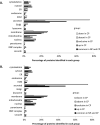Proteomic analysis (GeLC-MS/MS) of ePFT-collected pancreatic fluid in chronic pancreatitis
- PMID: 22243521
- PMCID: PMC3294251
- DOI: 10.1021/pr2011022
Proteomic analysis (GeLC-MS/MS) of ePFT-collected pancreatic fluid in chronic pancreatitis
Abstract
Chronic pancreatitis is characterized by inflammation, fibrosis, pain, and loss of exocrine function of the pancreas. We aimed to identify differentially expressed proteins in the ePFT-collected pancreatic fluid from individuals with chronic pancreatitis (CP; n = 9) and controls with chronic abdominal pain not associated with the pancreas (NP; n = 9). Using GeLC-MS/MS techniques, we identified a total of 1391 different proteins in 18 pancreatic fluid samples. Of these proteins, 257 and 413 were identified exclusively in the control and chronic pancreatitis cohorts, respectively, and 721 were identified in both cohorts. Spectral counting and statistical analysis thereof revealed an additional 38 and 77 proteins that were up- or down-regulated, respectively, in the pancreatic fluid from individuals with chronic pancreatitis. As expected, gene ontology analysis illustrated that the largest percentage of differentially regulated proteins was secreted/extracellular in origin. In addition, proteins that were down-regulated with statistical significance in the chronic pancreatitis cohort were determined to have biological function of proteases, corresponding to the canonical pancreatic insufficiency associated with chronic pancreatitis. Proteins enriched in the pancreatic fluid of chronic pancreatitis patients had roles in fibrosis, inflammation, and pain, whereas digestive enzymes were significantly less abundant. Our workflow provided a mass spectrometry-based approach for the further study of the pancreatic fluid proteome, which may lead to the discovery potential biomarkers of chronic pancreatitis.
Figures





Similar articles
-
Post-translational modifications of pancreatic fluid proteins collected via the endoscopic pancreatic function test (ePFT).J Proteomics. 2013 Oct 30;92:216-27. doi: 10.1016/j.jprot.2013.01.033. Epub 2013 Mar 14. J Proteomics. 2013. PMID: 23500127 Free PMC article. Clinical Trial.
-
Identification of pancreas-specific proteins in endoscopically (endoscopic pancreatic function test) collected pancreatic fluid with liquid chromatography--tandem mass spectrometry.Pancreas. 2010 Aug;39(6):889-96. doi: 10.1097/MPA.0b013e3181cf16f4. Pancreas. 2010. PMID: 20182389 Free PMC article.
-
Difference gel electrophoresis identifies differentially expressed proteins in endoscopically collected pancreatic fluid.Electrophoresis. 2011 Aug;32(15):1939-51. doi: 10.1002/elps.201100203. Electrophoresis. 2011. PMID: 21792986 Free PMC article.
-
Mass spectrometry-based proteomics of endoscopically collected pancreatic fluid in chronic pancreatitis research.Proteomics Clin Appl. 2011 Apr;5(3-4):109-20. doi: 10.1002/prca.201000098. Epub 2011 Mar 1. Proteomics Clin Appl. 2011. PMID: 21360826 Free PMC article. Review.
-
Proteomics as a systems approach to pancreatitis.Pancreas. 2013 Aug;42(6):905-11. doi: 10.1097/MPA.0b013e31828fddc3. Pancreas. 2013. PMID: 23851428 Free PMC article. Review.
Cited by
-
Screening preeclamptic cord plasma for proteins associated with decreased breast cancer susceptibility.Genomics Proteomics Bioinformatics. 2013 Dec;11(6):335-44. doi: 10.1016/j.gpb.2013.09.009. Epub 2013 Dec 5. Genomics Proteomics Bioinformatics. 2013. PMID: 24296084 Free PMC article.
-
Differentiating Branch Duct and Mixed IPMN in Endoscopically Collected Pancreatic Cyst Fluid via Cytokine Analysis.Gastroenterol Res Pract. 2012;2012:247309. doi: 10.1155/2012/247309. Epub 2012 Dec 25. Gastroenterol Res Pract. 2012. PMID: 23326260 Free PMC article.
-
Global Analysis of Protein Expression and Phosphorylation Levels in Nicotine-Treated Pancreatic Stellate Cells.J Proteome Res. 2015 Oct 2;14(10):4246-56. doi: 10.1021/acs.jproteome.5b00398. Epub 2015 Aug 24. J Proteome Res. 2015. PMID: 26265067 Free PMC article.
-
Multi-omic biomarker panel in pancreatic cyst fluid and serum predicts patients at a high risk of pancreatic cancer development.Sci Rep. 2025 Jan 2;15(1):129. doi: 10.1038/s41598-024-83742-4. Sci Rep. 2025. PMID: 39747972 Free PMC article.
-
A Novel Phosphopeptide Microarray Based Interactome Map in Breast Cancer Cells Reveals Phosphoprotein-GRB2 Cell Signaling Networks.PLoS One. 2013 Jun 27;8(6):e67634. doi: 10.1371/journal.pone.0067634. Print 2013. PLoS One. 2013. PMID: 23826330 Free PMC article.
References
-
- James S. Opportunities and challenges at NIDDK in digestive diseases research. Gastroenterology. 2007;132:1219–1220. - PubMed
-
- Chowdhury R, Bhutani MS, Mishra G, Toskes PP, Forsmark CE. Comparative analysis of direct pancreatic function testing versus morphological assessment by endoscopic ultrasonography for the evaluation of chronic unexplained abdominal pain of presumed pancreatic origin. Pancreas. 2005;31(1):63–8. - PubMed
-
- DiMagno EP, Go VL, Summerskill WH. Relations between pancreatic enzyme ouputs and malabsorption in severe pancreatic insufficiency. N Engl J Med. 1973;288(16):813–5. - PubMed
-
- Chen R, Brentnall TA, Pan S, Cooke K, Moyes KW, Lane Z, Crispin DA, Goodlett DR, Aebersold R, Bronner MP. Quantitative proteomics analysis reveals that proteins differentially expressed in chronic pancreatitis are also frequently involved in pancreatic cancer. Mol Cell Proteomics. 2007;6(8):1331–42. - PubMed
Publication types
MeSH terms
Substances
Grants and funding
LinkOut - more resources
Full Text Sources
Research Materials
Miscellaneous

